
1 Palace Green is a Grade II* listed house on Palace Green, Kensington, London, England. [1] It was built by Arts and Crafts architect Philip Webb, completed in 1870 with additions in 1874, and decorated by Morris, Marshall, Faulkner & Company.

1 Palace Green is a Grade II* listed house on Palace Green, Kensington, London, England. [1] It was built by Arts and Crafts architect Philip Webb, completed in 1870 with additions in 1874, and decorated by Morris, Marshall, Faulkner & Company.
Webb designed the house over 1867–68 as a studio house for George Howard, a painter and the future 9th Earl of Carlisle, and his wife Rosalind Howard. [2] The couple were associated with the Holland Park Circle of artists, and close friends of the artist Edward Burne-Jones. [3]
Webb saw his design as a return to London building traditions. His use of plain red brick, sash windows and a large gable on the street front provoked opposition from James Pennethorne, the surveyor for the Commissioners of Woods, Forests and Land Revenues, whose approval was needed as the site was leased from the Crown Estate. [2] Pennethorne could not understand the Arts and Crafts architect's nonconformance to any traditional style or period of architecture, and thought the design vulgar compared to those of neighbouring developments, which Webb in turn despised. [4] After a long dispute which grew to include other prominent architects, Webb agreed to add some more Portland stone dressings and redesign the gable. The house was constructed over 1868–70. [2]

The L-plan [1] house was tall compared to the neighbouring properties, having a kitchen basement level and three residential levels, with gables above. On the front elevation there is a two-storey bay window, projecting over the ground storey, surmounted by a parapet and the large, stone-faced gable. [2] The porch incorporates a pointed arch. [1] Webb positioned Howard's studio on the north side of the top residential storey, with its own staircase which led down to the garden, opening into a two-storey pointed-arch recess. In 1873–74 Webb returned to add a schoolroom next to the studio, over another tall pointed-arch recess, in the south elevation. [2]
The house was furnished by Morris, Marshall, Faulkner & Company, in a style with painted ceilings and panelling which was similar to that of the Green Dining Room furnished by the company at the South Kensington Museum. [5] William Morris worked on decorating the ceiling and walls of the house's dining room until 1881. This room also featured Cupid and Psyche, a frieze of 12 canvases started by Burne-Jones in 1870, based on the story in Morris's epic poem The Earthly Paradise . [6] Burne-Jones completed it in 1882. [7] Burne-Jones's painting Dies Domini hung in the drawing room. The decoration of Rosalind Howard's boudoir was entirely based around the hanging of his large 1879 painting The Annunciation. [8]
The Howards later employed the company to decorate their other residences, Naworth Castle and Castle Howard, and their influence led to the commissioning of Webb as architect and the company as decorators for St Martin's Church, Brampton. [9]
Widowed in 1911, Rosalind Howard sold the house in 1920, moving along and across the street to 13 Kensington Palace Gardens. [10]
In 1957 the Crown Commissioners broke the house up into apartments. [11]

William Morris was a British textile designer, poet, artist, fantasy writer, and socialist activist associated with the British Arts and Crafts movement. He was a major contributor to the revival of traditional British textile arts and methods of production. His literary contributions helped to establish the modern fantasy genre, while he helped win acceptance of socialism in fin de siècle Great Britain.
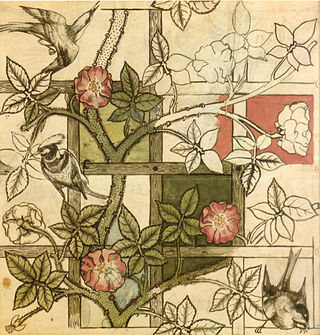
The Arts and Crafts movement was an international trend in the decorative and fine arts that developed earliest and most fully in the British Isles and subsequently spread across the British Empire and to the rest of Europe and America.

Sir Edward Coley Burne-Jones, 1st Baronet, was a British painter and designer associated with the Pre-Raphaelite Brotherhood which included Dante Gabriel Rossetti, John Millais, Ford Madox Brown and William Holman Hunt. Burne-Jones worked with William Morris as a founding partner in Morris, Marshall, Faulkner & Co in the design of decorative arts.

Sir Aston Webb, was a British architect who designed the principal facade of Buckingham Palace and the main building of the Victoria and Albert Museum, among other major works around England, many of them in partnership with Ingress Bell. He was President of the Royal Academy from 1919 to 1924. He was also the founding Chairman of the London Society.

Philip Speakman Webb was a British architect and designer sometimes called the Father of Arts and Crafts Architecture. His use of vernacular architecture demonstrated his commitment to "the art of common building." William Morris, Edward Burne-Jones and Dante Gabriel Rossetti were his business partners and he designed many notable buildings including one for Morris. He co-founded the Society for the Protection of Ancient Buildings.

Red House is a significant Arts and Crafts building located in Bexleyheath, south-east London, England. Co-designed in 1859 by the architect Philip Webb and the designer William Morris, it was created to serve as a family home for Morris. Construction was completed in 1860.

Morris, Marshall, Faulkner & Co. (1861–1875) was a furnishings and decorative arts manufacturer and retailer founded by the artist and designer William Morris with friends from the Pre-Raphaelites. With its successor Morris & Co. (1875–1940) the firm's medieval-inspired aesthetic and respect for hand-craftsmanship and traditional textile arts had a profound influence on the decoration of churches and houses into the early 20th century.

Second Presbyterian Church is a landmark Gothic Revival church located on South Michigan Avenue in Chicago, Illinois, United States. In the late nineteenth and early twentieth centuries, some of Chicago's most prominent families attended this church. It is renowned for its interior, completely redone in the Arts and Crafts style after a disastrous fire in 1900. The sanctuary is one of America's best examples of an unaltered Arts and Crafts church interior, fully embodying that movement's principles of simplicity, hand craftsmanship, and unity of design. It also boasts nine imposing Tiffany windows. The church was listed on the National Register of Historic Places in 1974 and later designated a Chicago Landmark on September 28, 1977. It was designated a National Historic Landmark in March 2013.
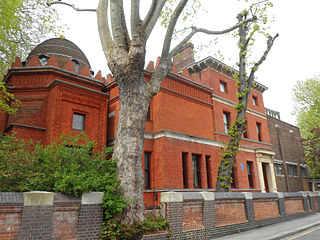
The Leighton House Museum is an art museum in the Holland Park area of the Royal Borough of Kensington and Chelsea in west London.

A revival of the art and craft of stained-glass window manufacture took place in early 19th-century Britain, beginning with an armorial window created by Thomas Willement in 1811–12. The revival led to stained-glass windows becoming such a common and popular form of coloured pictorial representation that many thousands of people, most of whom would never commission or purchase a painting, contributed to the commission and purchase of stained-glass windows for their parish church.
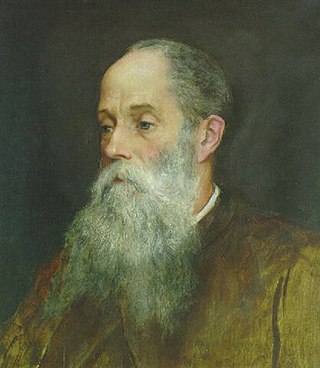
John Roddam Spencer Stanhope was an English artist associated with Edward Burne-Jones and George Frederic Watts and often regarded as a second-wave pre-Raphaelite. His work is also studied within the context of Aestheticism and British Symbolism. As a painter, Stanhope worked in oil, watercolor, fresco, tempera, and mixed media. His subject matter was mythological, allegorical, biblical, and contemporary. Stanhope was born in Yorkshire, England, and died in Florence, Italy. He was the uncle and teacher of the painter Evelyn De Morgan.

Clouds House, also known simply as Clouds, is a Grade II* listed building at East Knoyle in Wiltshire, England. Designed by Arts and Crafts architect Philip Webb for Percy Wyndham and his wife Madeline, it was first completed in 1886, but an 1889 fire necessitated its rebuilding, finished in 1891. Clouds was Webb's grandest design. It became a centre of social activity for the intellectual group known as The Souls, and was frequented by artists such as Edward Burne-Jones and politicians like Arthur Balfour.
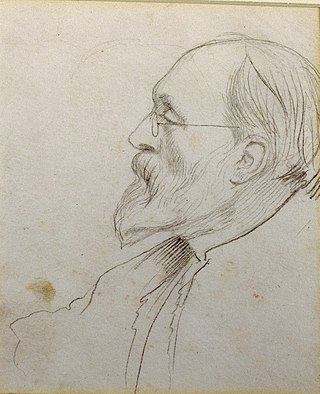
George James Howard, 9th Earl of Carlisle, known as George Howard until 1889, was an English aristocrat, peer, politician, and painter. He was the last Earl of Carlisle to own Castle Howard.

The Modern Style is a style of architecture, art, and design that first emerged in the United Kingdom in the mid-1880s. It is the first Art Nouveau style worldwide, and it represents the evolution of the Arts and Crafts movement which was native to Great Britain. Britain not only provided the base and intellectual background for the Art Nouveau movement, which was adapted by other countries to give birth to local variants; they also played an over-sized role in its dissemination and cultivation through the Liberty department store and The Studio magazine. The most important person in the field of design in general, and architecture in particular, was Charles Rennie Mackintosh. He created one of the key motifs of the movement, now known as the 'Mackintosh rose' or 'Glasgow rose'. The Glasgow School was also of tremendous importance, particularly due to a group closely associated with Mackintosh, known as 'The Four'. The Liberty store nurturing of style gave birth to two metalware lines, Cymric and Tudric, designed by Archibald Knox. In the field of ceramic and glass Christopher Dresser is a standout figure. Not only did he work with the most prominent ceramic manufacturers but became a crucial person behind James Couper & Sons' trademarking of Clutha glass, inspired by ancient Rome, in 1888. Aubrey Beardsley was a defining person in graphic design and drawing, and influenced painting and style in general. In textiles William Morris and C. F. A. Voysey are of huge importance, although most artists were versatile and worked in many mediums and fields, influencing them all to an extent. Because of the natural evolution of Arts and Crafts to Modern Style, lines can be blurred and many designers, artists, and craftsmen worked in both styles simultaneously. Important figures include Charles Robert Ashbee, Walter Crane, Léon-Victor Solon, George Skipper, Charles Harrison Townsend, Arthur Mackmurdo, William James Neatby.
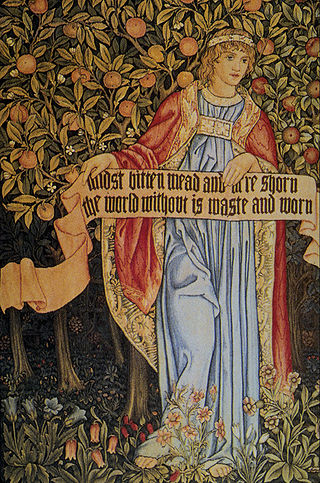
John Henry Dearle was a British textile and stained-glass designer trained by the artist and craftsman William Morris who was much influenced by the Pre-Raphaelite Brotherhood. Dearle designed many of the later wallpapers and textiles released by Morris & Co., and contributed background and foliage patterns to tapestry designs featuring figures by Edward Burne-Jones and others. Beginning in his teens as a shop assistant and then design apprentice, Dearle rose to become Morris & Co.'s chief designer by 1890, creating designs for tapestries, embroidery, wallpapers, woven and printed textiles, stained glass, and carpets. Following Morris's death in 1896, Dearle was appointed Art Director of the firm, and became its principal stained glass designer on the death of Burne-Jones in 1898.

St Martin's Church is in Front Street, Brampton, Cumbria, England. It is an active Anglican parish church in the deanery of Brampton, the archdeaconry of Carlisle and the diocese of Carlisle. It is recorded in the National Heritage List for England as a designated Grade I listed building and is the only church designed by the Pre-Raphaelite architect Philip Webb. The architectural historian Nikolaus Pevsner described it as "a very remarkable building".
Charles Joseph Faulkner (1833–1892) was a British mathematician and fellow of University College, Oxford and a founding partner of Morris, Marshall, Faulkner and Co. where he worked with his sisters Kate Faulkner and Lucy Faulkner Orrinsmith.

Georgiana, Lady Burne-Jones was a painter and engraver, and the second oldest of the Macdonald sisters. She was married to the Late Pre-Raphaelite artist Edward Burne-Jones, and was also the mother of painter Philip Burne-Jones, aunt of novelist Rudyard Kipling and Prime Minister Stanley Baldwin, confidante and friend of George Eliot, William Morris, and John Ruskin. She was a Trustee of the South London Gallery and was elected to the parish Council of Rottingdean, near Brighton in Sussex.
Beverley Ussher was articled to Melbourne architect Alfred Dunn. Dunn was English and had worked for architect Alexander Lauder in Barnstaple, Devon, where he worked with Arts and Crafts movement theorist and practitioner W.R. Lethaby. Through Dunn's English connections, when Ussher completed his architecture articles in Melbourne, he visited England and was introduced to architect Walter Butler. Later Ussher and Butler formed a partnership in Melbourne.

The Great Bookcase is a large piece of painted furniture designed by the English architect and designer William Burges. The bookcase is 10 feet (3.0 m) high and 5 feet (1.5 m) wide. It has been described as "the most important example of Victorian painted furniture ever made."
![]() Media related to 1 Palace Green at Wikimedia Commons
Media related to 1 Palace Green at Wikimedia Commons